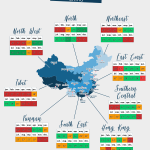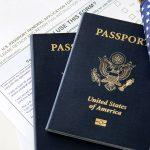China is currently shining brightly both economically and culturally. It boasts the second largest economy in the world, which is still rapidly developing. Additionally, China holds the title of being the most populous country in the world, with a population of nearly 1.37 billion as of 2014. Encompassing approximately 9.6 million square kilometers, China is the third largest country in the world, featuring a vast and diverse landscape.
As the cradle of civilization, early hominids originated in the fertile basin of the Yellow River between 250,000 and 2.24 million years ago, eventually establishing the first dynasty – Xian. Since then, a glorious history and culture have been cultivated. Today, China stands as one of the most sought-after travel destinations globally.
Official Name: The People’s Republic of China (PRC)
Capital City: Beijing
Official Language: Standard Chinese (Mandarin)
Area: 9,596,961 km2 (3,705,407 sq mi)
Population: 1.41175 billion (2022)
GDP: $17963.17 billion USD (2022)
Location: East Asia, adjacent to Vietnam, Laos, Myanmar, India, Bhutan, Nepal, Pakistan, Afghanistan, Tajikistan, Kyrgyzstan, Kazakhstan, Russia, Mongolia, and North Korea.
Territorial Seas: the Bohai Sea, the Yellow Sea, the East China Sea, and the South China Sea
Climate: mainly dominated by dry seasons and wet monsoons
Time Zone: China Standard Time (UTC+8)
People: 91.51% Han and 55 ethnic groups
Religions: Confucianism, Buddhism, Taoism, Islam, Catholicism, Protestantism or Atheist
Currency:Renminbi (yuan)(¥)(CNY):
Calling Code:+86
Largest City: Shanghai
Capital City – Beijing
Beijing, the current capital city of China, serves as the political, cultural, and educational hub of the nation. As a direct-controlled municipality under the national government, Beijing boasts one of the largest populations in the world, totaling 21.689 million residents. The city is comprised of 14 districts and 2 counties, situated adjacent to Hebei Province and Tianjin City.
The rich history of Beijing dates back approximately three thousand years, with its most illustrious period spanning six hundred years as the capital city during the Yuan, Ming, and Qing Dynasties. Beijing is renowned for its seven UNESCO World Heritage Sites, which include the Forbidden City, Temple of Heaven, Summer Palace, Great Wall, Ming Tombs, Zhoukoudian, and the Grand Canal.
Overall, Beijing stands as a testament to China’s ancient past and vibrant present, attracting visitors from around the globe to experience its cultural treasures and historical significance.
Administrative Division & Travel Regions
Northeast China – Liaoning, Jilin, Heilongjiang Provinces
Old manufacturing cities, diverse natural resources such as forests, plains, and prairies, and winter holidays are just a few of the unique features that make this region truly special.
North China – Shandong, Shanxi, Inner Mongolia, Henan, Hebei, Beijing, Tianjin
The Yellow River has long been recognized as the cradle of China’s civilization, shaping the development of this region for centuries.
Northwest China – Shaanxi, Gansu, Ningxia, Qinghai, Xinjiang
The ancient Silk Road boasts a rich and illustrious history, while the diverse natural landscape adds to its allure.
Southwest China – Tibet, Yunnan, Guangxi, Guizhou
Explore the rich tapestry of ethnic culture, the spiritual depths of Tibetan Buddhism, and the breathtaking beauty of wild natural scenery.
South-central China – Anhui, Sichuan, Chongqing, Hubei, Hunan, Jiangxi
The Yangtze River has created a fertile region, characterized by stunning mountains and flowing rivers.
Southeast China – Guangdong, Hainan, Fujian
Key international trading hubs and ports located along the coast.
East China – Jiangsu, Shanghai, Zhejiang
The most developed regions are characterized by their traditional water towns and gardens. These areas are known for their rich cultural heritage and stunning natural landscapes.
Geography
Located in Southeast Asia, China is the third largest country in the world, covering a total area of 9,596,961 km2 (3,705,407 sq mi) and bordering 14 nations including Vietnam, Laos, Myanmar, India, Bhutan, Nepal, Pakistan, Afghanistan, Tajikistan, Kyrgyzstan, Kazakhstan, Russia, Mongolia, and North Korea.
Approximately 67% of China’s land consists of mountains, plateaus, and hills, while basins and plains make up the remaining 33%. The terrain features terraces that are higher in the west and lower in the east. The westernmost part of China is the Qinghai-Tibet Plateau, known as the “roof of the world,” with an average altitude of over 4,000m.
Moving eastward and northward, the altitude decreases to an average of 1,000-2,000m, showcasing diverse landforms such as mountains and deserts in Xinjiang, Inner Mongolia, the Loess Plateau, Sichuan Basin, and Yungui Plateau. The southern, eastern, and northeastern regions of China are mainly characterized by plains and hills, with an average altitude of 500-1,000m.
World Heritage Sites
China became a state party to the International Convention Concerning the Protection of World Cultural and Natural Heritage in 1985. With its profound culture and abundant natural resources, China boasts an impressive 48 UNESCO world heritage sites, trailing only behind Italy with 50. Among these sites, 34 are cultural heritage sites, 10 are natural heritage sites, and 4 are mixed cultural and natural heritage sites.
Beijing stands out as the city with the most heritage sites, boasting 7 world cultural sites including iconic landmarks such as the Great Wall, Forbidden City, Temple of Heaven, and Summer Palace. Sichuan follows closely behind with 5 heritage sites, including popular tourist destinations like Jiuzhaigou, Mount Emei & Leshan Giant Buddha, and Sichuan Giant Panda Sanctuaries.
Other notable sites in China, such as Zhangjiajie National Park, Mogao Caves, Silk Road, and Potala Palace, attract millions of travelers from around the world each year. These sites not only showcase China’s rich history and natural beauty but also contribute to the country’s thriving tourism industry.
Famous Rivers
China is home to over 5,000 rivers, each with its own unique characteristics. The country’s diverse terrain, with high elevations in the west and lower elevations in the east, allows many rivers to flow eastward towards the Yellow Sea, Bo Sea, or the East Sea of the Pacific Ocean.
Among the top 10 most famous rivers in China are the Yangtze River, stretching an impressive 6,300 kilometers, the Yellow River at 5,464 kilometers, the Pearl River at 2,200 kilometers, the Songhuajiang River at 1,927 kilometers, the Heilongjiang River at 4,370 kilometers, the Yarlung Zangbo River at 2,900 kilometers, the Nujiang River at 2,816 kilometers, the Lancangjiang River at 2,354 kilometers, the Hanjiang River at 1,532 kilometers, and the Liaohe River at 1,394 kilometers.
The Yangtze River, the longest river in China and the third longest in the world, originates from the Qinghai-Tibet Plateau and flows through the southwestern and southern fertile regions of China. It is renowned for its stunning gorges and breathtaking scenery.
The Yellow River, known as the cradle of Chinese civilization, begins in Qinghai and winds its way through nine provinces in northern China before emptying into the Bo Sea. Along its banks, a rich history and culture have flourished, making it a symbol of China’s heritage.
Famous Mountains
China is a country known for its vast and majestic mountain ranges. From lofty peaks to snow-capped summits, each mountain in China tells a unique story. Some are steeped in religious significance, while others are shrouded in folklore and legend.
Among the most famous mountains in China are the Five Great Mountains, known as Wuyue. These include Mount Tai in Shandong, Mount Hua in Shaanxi, Hengshan Mountain in Hunan, Mount Heng in Shanxi, and Mount Song in Henan. These mountains have long been revered as imperial pilgrimage sites and hold great religious importance.
In addition to the Five Great Mountains, China is home to the Four Sacred Mountains of Buddhism. Each of these mountains is associated with a Bodhisattva and holds special significance for Buddhist pilgrims. Mount Wutai in Shanxi, Mount Emei in Sichuan, Mount Jiuhua in Anhui, and Mount Putuo are all considered sacred sites for followers of Buddhism.
Taoism also has its own sacred mountains in China, including Mount Wudan, Mount Longhu, Mount Qiyun, and Mount Qingcheng. These mountains are believed to be places of great spiritual power and are popular destinations for Taoist pilgrims.
The Qinghai-Tibet Plateau is another region in China that attracts visitors from around the world. Home to some of the highest peaks on earth, including Mount Everest and Mount Kailash, this plateau is a haven for climbers, adventurers, and Buddhist pilgrims seeking spiritual enlightenment in the shadow of these magnificent mountains.
Traditional Festivals & Public Holidays
Traditional Festivals
Traditional festivals play a significant role in Chinese history, showcasing a rich cultural heritage that has been passed down from ancient times. These festivals are typically scheduled according to the Chinese Lunar Calendar, marking important events such as harvests or prayer offerings. With dozens of festivals celebrated each year, some of the most notable ones include the Spring Festival (1st day of the 1st Month), Lantern Festival (15th day of the 1st Month), Qingming Festival (April 5), Dragon Boat Festival (5th day of the 5th Month), and the Mid-Autumn Festival (15th day of the 8th month). These festivals not only hold historical significance but also serve as a time for communities to come together and celebrate their cultural traditions.
Public Holidays
In China, there are currently seven official public holidays that allow people to enjoy either three days or a full week off for vacation. However, the final dates for these holidays are not set until about three weeks before the next year. Two of the most popular holidays, the Spring Festival and National Day, provide a week off known as the “golden week,” which is also a peak season for tourism. It is highly recommended for foreign travelers to plan their itineraries and make hotel and flight reservations as early as possible to avoid any inconveniences.
The other five public holidays in China include New Year’s Day (January 1st), Qingming Festival (April 4th or 5th), May Day (May 1st), Dragon Boat Festival (5th day of the 5th month), and Mid-Autumn Festival (15th day of the 8th month), each offering a three-day holiday.
Ethnic Groups in China
China, the most populous country in the world, is home to 56 diverse ethnic groups. The majority of the population, around 93%, are Chinese Han people, while the remaining 7% are non-Han Chinese, often referred to as minorities (Shaoshu Minzu – 少数民族).
Among the major minority ethnic groups in China are the Zhuang (16.9 million), Uyghur (11.5 million), Hui (10.5 million), Manchu (10.3 million), Miao (9.4 million), Yi (8.7 million), Tujia (8.3 million), Tibetan (6.2 million), Mongol (5.9 million), Dong (2.8 million), Buyei (2.8 million), Yao (2.7 million), Bai (1.9 million), Korean (1.8 million), Hani (1.6 million), Li (1.4 million), Kazakh (1.4 million), and Dai (1.2 million).
China has designated 5 autonomous regions (provinces) for specific ethnic groups, including Tibet (Tibetan), Ningxia (Hui Muslim), Guangxi (Zhuang), Xinjiang (Uyghur), and Inner Mongolia (Mongol). Other provinces with significant ethnic populations include Guizhou, Yunnan, Sichuan, and Hunan.






















